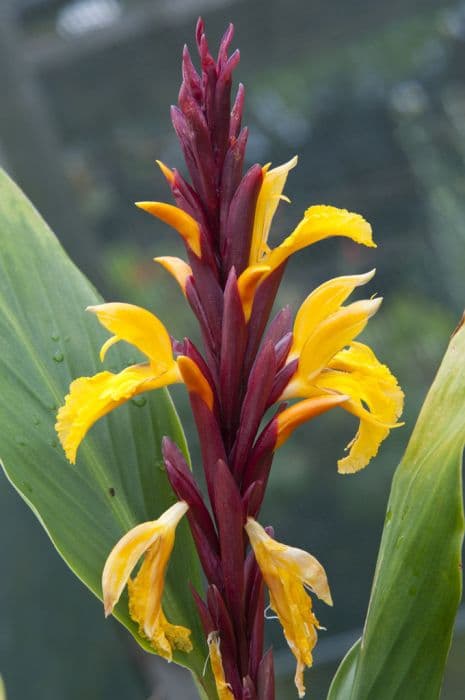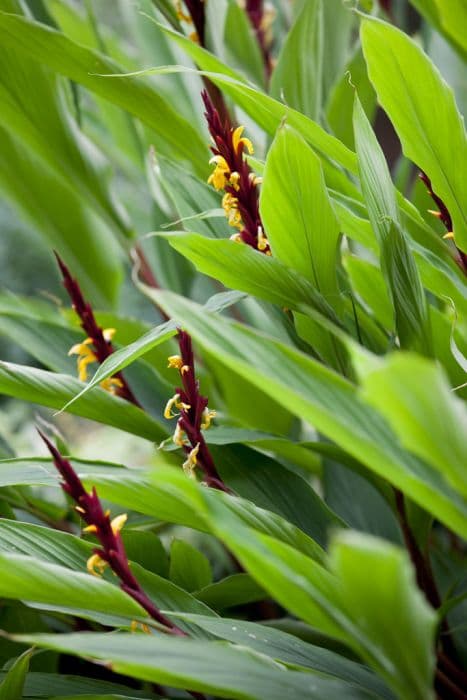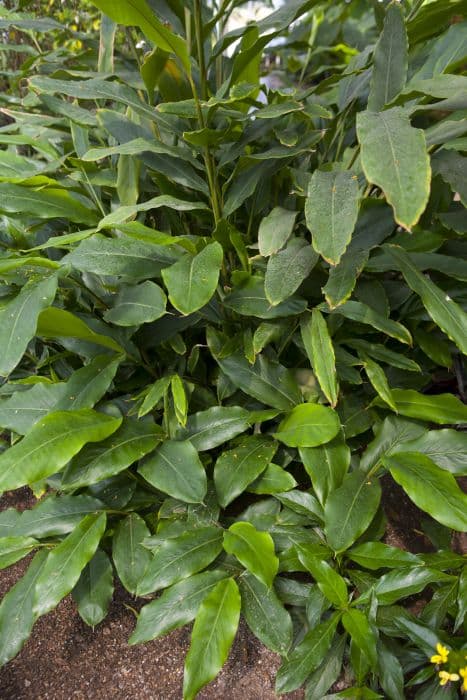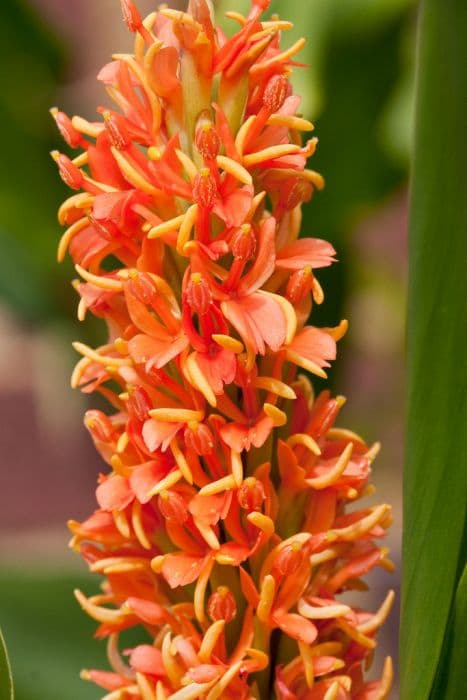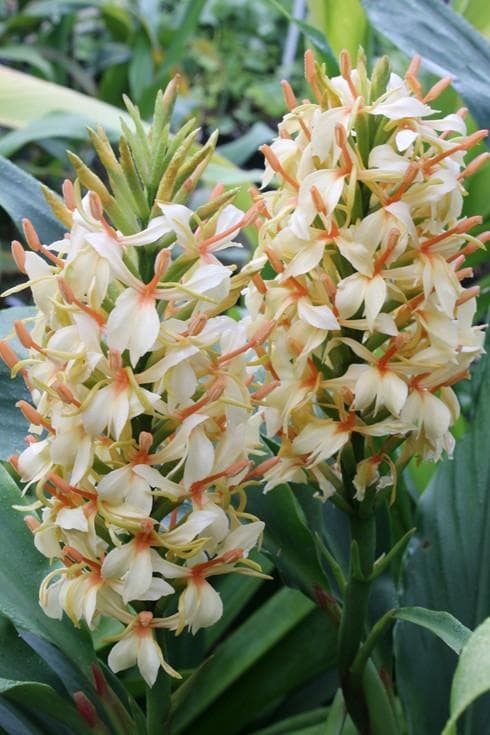Roscoea Roscoea humeana f. humeana

ABOUT
Roscoea humeana f. humeana, commonly referred to as Roscoea, is a perennial plant known for its distinctive and attractive appearance. The plant displays a clump of narrow, lance-shaped leaves that are typically bright green, creating a lush and dense foliage base. Emerging from the leaves, the flower stems carry prominent blooms which are quite showy. The flowers of Roscoea boast an intricate design, often in shades of purple, lilac, or sometimes white, with a distinctive labellum or lip that is often a contrasting color, adding to their exotic allure. The labellum is typically large and acts as a landing platform for pollinators. The petals and sepals of the flower form a tubular structure, giving it an elegant, elongated look. Adding to the charm of the plant are the delicate stamen and pistil that protrude from the center of the bloom, indispensable components for the reproductive process. These reproductive parts are often surrounded by a fine, sometimes hairy, texture that can be observed upon closer inspection of the flowers. Together, the leaves and flowers create a harmonious visual with an appealing texture and color palette that make Roscoea a prized specimen in gardens where it is cultivated for its ornamental qualities. Its blooms usually appear in the summertime, capturing the attention of both garden enthusiasts and pollinating insects.
About this plant
 Names
NamesFamily
Zingiberaceae
Synonyms
Hume's Roscoea
Common names
Roscoea humeana f. humeana.
 Toxicity
ToxicityTo humans
Roscoea purpurascens, commonly known as the Roscoea, does not have a well-documented profile for toxicity to humans. There is no significant evidence of it being highly toxic, and it is not commonly listed among plants that are known to cause poisoning when ingested. Nevertheless, it's always wise to exercise caution and avoid eating plants not known to be safe for consumption. If you suspect poisoning from any plant, seek medical attention promptly.
To pets
Roscoea purpurascens, the common name Roscoea, is not widely recognized for being toxic to pets. There is limited information on its effects when ingested by animals. However, as with any non-food plants, it is generally advisable to prevent pets from consuming it, since individual animals might have specific sensitivities. If your pet exhibits signs of illness after ingesting any part of this plant, consult a veterinarian. Symptoms of plant poisoning in pets can include vomiting, diarrhea, drooling, and lethargy.
 Characteristics
CharacteristicsLife cycle
Perennials
Foliage type
Deciduous
Color of leaves
Green
Flower color
Purple
Height
1 foot [30 cm]
Spread
0.5 feet [15 cm]
Plant type
Herb
Hardiness zones
6
Native area
China
Benefits
 General Benefits
General Benefits- Ornamental Value: Roscoea humeana f. humeana, commonly known as Roscoea, is appreciated for its striking flowers and can add aesthetic beauty to gardens and landscapes.
- Pollinator Attraction: The flowers of the Roscoea can attract pollinators such as bees and butterflies, contributing to the health of the local ecosystem.
- Biodiversity Support: By providing habitat and food for pollinators and other wildlife, Roscoea can play a role in promoting biodiversity.
- Low Maintenance: Roscoea is known for being relatively easy to care for, requiring minimal upkeep once established, which makes it suitable for gardeners of varying expertise.
- Cultural Significance: In some cultures, Roscoea species are celebrated for their unique appearance and may be featured in gardens for cultural or historical reasons.
 Medical Properties
Medical PropertiesThis plant is not used for medical purposes.
 Air-purifying Qualities
Air-purifying QualitiesThis plant is not specifically known for air purifying qualities.
 Other Uses
Other Uses- Roscoea humeana can be incorporated into ornamental gardens for aesthetic purposes, showcasing its striking purple-to-violet flowers during the blooming season.
- This plant can be used in the study and education of alpine and mountainous plant species, as it originates from the mountainous regions of China.
- The plant can sometimes be used in botanical illustrations and plant photography due to its unique floral structure.
- Eco-friendly landscaping practices can utilize Roscoea humeana as it likely requires less water compared to non-native plants in regions similar to its natural habitat.
- The robust rhizomes of Roscoea humeana could potentially be used in erosion control on sloped gardens and landscapes.
- Hobbyist plant breeding programs might include Roscoea humeana to create new hybrids or cultivars with unique characteristics.
- Parts of the plant might be used in crafting or as a natural dye source, depending on local traditions and experimentation with the species.
- Some gardeners might use Roscoea humeana in companion planting to create beneficial plant communities and enhance biodiversity.
- The plant can play a role in butterfly and bee gardens as its flowers may attract pollinators during their flowering season.
- Collectors of rare and exotic plants may value Roscoea humeana as an addition to their collections due to its specific growing conditions and rarity outside its natural habitat.
Interesting Facts
 Feng Shui
Feng ShuiThe plant Roscoea is not used in Feng Shui practice.
 Zodiac Sign Compitability
Zodiac Sign CompitabilityThe plant Roscoea is not used in astrology practice.
 Plant Symbolism
Plant Symbolism- Exotic Appeal: As a less commonly known plant, Roscoea humeana f. humeana signifies a sense of exoticness and uniqueness, representing things that are out of the ordinary or unusual.
- Delicacy: Due to its delicate flowers and structure, the plant can symbolize the fragility and the need for careful handling in sensitive situations.
- Elegance: With its beautiful flowers, Roscoea humeana f. humeana can represent the idea of gracefulness and refined beauty.
- Endurance: As a plant that can withstand cooler temperatures compared to other tropical species, it might symbolize the ability to endure and adapt to difficult conditions.
- Simplicity: Despite being exotic, the Roscoea humeana f. humeana has a straightforward growth habit, which could be associated with an appreciation for simplicity and minimalism.
 Water
WaterThe Roscoea humeana, commonly known as Himalayan ginger, should be watered thoroughly, making sure the soil is evenly moist but not waterlogged. During the active growing season in spring and summer, water the plant once a week with about a gallon of water, ensuring the top inch of soil dries out between waterings. In the fall and winter, reduce watering to every other week or less, depending on humidity levels and temperature, as the plant enters a dormant phase.
 Light
LightHimalayan ginger thrives in partial shade with bright, indirect light. The best spot for this plant would be in an area that receives morning sun and afternoon shade or a location with dappled sunlight throughout the day. Avoid placing it in full, direct sunlight as this can scorch the leaves and stress the plant.
 Temperature
TemperatureHimalayan ginger prefers moderate temperatures and should be kept between 50°F and 75°F for optimal growth. It can survive minimum temperatures down to 32°F, but frost can damage the foliage. The ideal temperature range would be 60°F to 70°F during the day, with slightly cooler temperatures at night.
 Pruning
PruningPruning Himalayan ginger is generally not required, as the plant has a tidy growth habit. However, if necessary, prune to remove dead or damaged foliage and encourage new growth. The best time for pruning is in early spring before new growth begins. Pruning can be done as often as needed to maintain the desired shape and health of the plant.
 Cleaning
CleaningAs needed
 Soil
SoilRoscoea prefers well-draining soil with rich organic matter, ideally a mix of loam and sand or perlite, with a pH between 6.0 and 6.5 to thrive.
 Repotting
RepottingRoscoeas should be repotted every 2 to 3 years or when the rhizomes have filled the pot to reinvigorate growth and replenish nutrients.
 Humidity & Misting
Humidity & MistingRoscoeas require moderate humidity levels, around 40-60% is typically suitable for their growth needs.
 Suitable locations
Suitable locationsIndoor
Place in bright, indirect light and ensure moderate humidity for Roscoea.
Outdoor
Plant in partial shade with shelter from strong winds for Roscoea.
Hardiness zone
6-9 USDA
 Life cycle
Life cycleRoscoea humeana f. humeana, commonly known as Roscoea, begins its life cycle as a seed which germinates in moist, well-drained soil during the spring. After germination, it develops a root system and shoots that emerge above ground, forming a rosette of lanceolate leaves. The plant then enters its vegetative growth stage, during which it continues to produce more foliage and gains strength. Following the vegetative stage, Roscoea humeana f. humeana enters the flowering stage, typically in late spring or early summer, where it produces distinctive purple flowers that are pollinated by insects. After pollination, the flowers give way to seed capsules containing numerous small seeds, completing the reproductive phase. With the onset of winter or dry conditions, the plant enters dormancy, with its above-ground parts dying back, and it remains dormant until the next appropriate growing season commences.
 Propogation
PropogationPropogation time
Spring to early summer
Propogation: Roscoea humeana f. humeana, commonly known as Roscoea, is typically propagated by division of its rhizomes. The ideal time to propagate Roscoea by division is in late winter to early spring just before new growth begins. The process involves carefully digging up the plant, ensuring not to damage the rhizomes. Once the rhizomes are exposed, gardeners can divide them by gently pulling or cutting them apart, making sure each division has at least one growth bud. These divisions can then be replanted in well-draining soil at a depth of about 1 to 2 inches (2.5 to 5 cm), spaced approximately 8 to 12 inches (20 to 30 cm) apart to allow for adequate growth. The soil should be kept consistently moist but not waterlogged to encourage rooting and new growth. With proper care, the divisions will establish themselves and start to grow into new plants.
